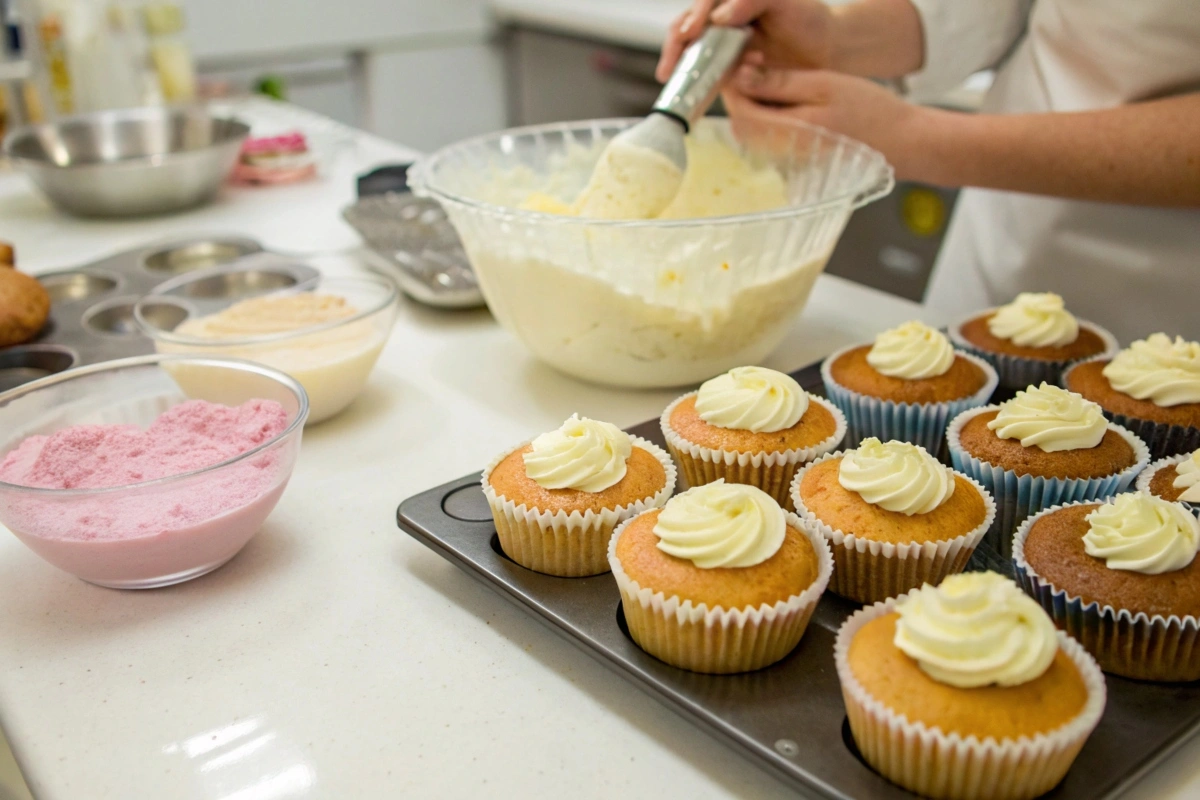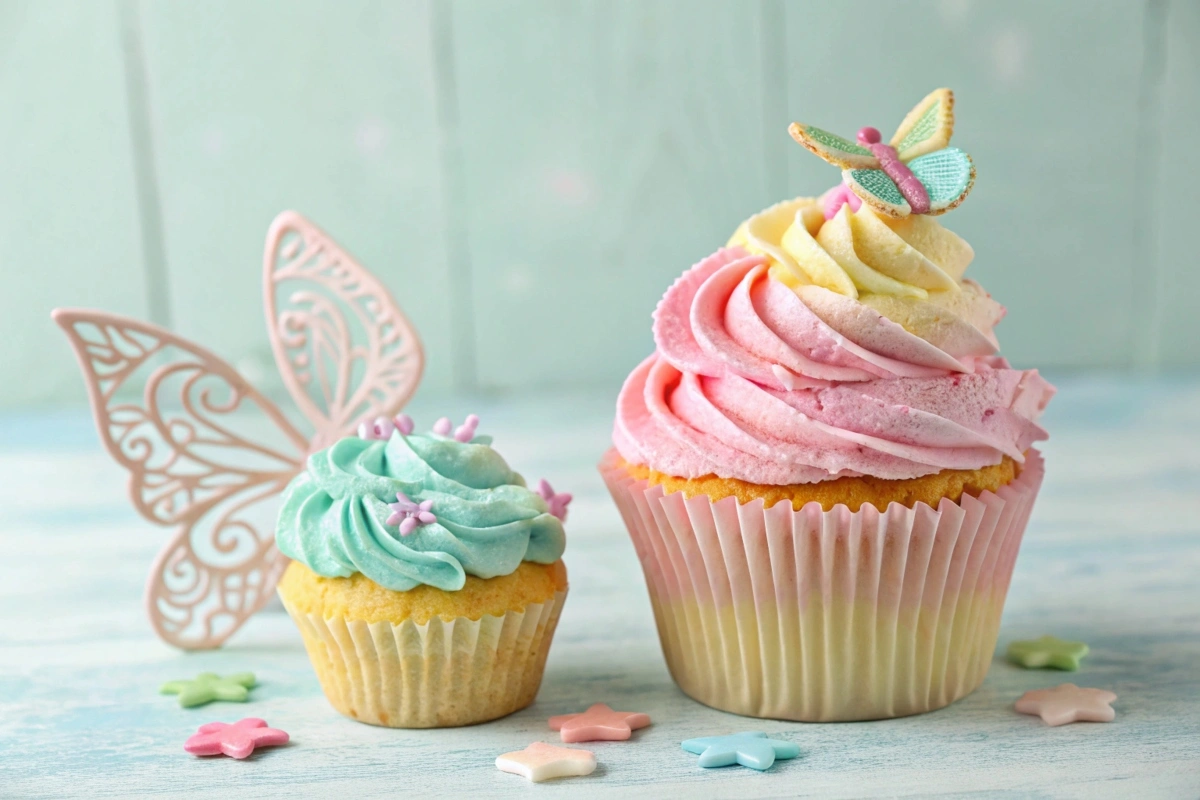When it comes to delightful miniature desserts, fairy cakes and cupcakes often steal the spotlight. But what’s the difference between a fairy cake and a cupcake? Despite their similarities, these treats are unique in size, style, and purpose. This article dives into their origins, differences in baking techniques, ingredients, cultural significance, and much more. By the end, you’ll not only understand these tasty treats but also know which one is perfect for your next occasion.
Introduction
What Are Fairy Cakes and Cupcakes?
Fairy cakes and cupcakes might seem similar at first glance, but they’ve got their own distinct identities. Fairy cakes, a classic favorite in the UK, are typically small, dainty, and topped with a simple glaze or icing. Cupcakes, on the other hand, are the larger, more indulgent cousins popular in the US, with an elaborate dollop of buttercream frosting or decorative toppings.
Why Is It Important to Differentiate Between Them?
Understanding the difference between these two desserts isn’t just for baking enthusiasts. These distinctions reflect diverse culinary traditions, aesthetic choices, and even how desserts are enjoyed in different parts of the world. Whether you’re planning a party, preparing for a bake-off, or simply satisfying your sweet tooth, knowing what sets a fairy cake apart from a cupcake will help you make informed choices. Plus, it’s a fun piece of trivia to impress your friends with!
The Origins and History of Fairy Cakes and Cupcakes
The Historical Roots of Fairy Cakes in the UK
Fairy cakes, as their whimsical name suggests, have deep roots in British baking traditions. Originating as a simpler, smaller version of sponge cakes, these treats gained popularity in the Victorian era. Back then, the name “fairy cake” symbolized their small size, perfect for serving mythical creatures like fairies or so the story goes! They were traditionally baked for children’s parties or teatime treats, making them a staple in British households.
Their simplicity was part of the charm. A basic Victoria sponge mix formed the base, topped with a light glaze or a sprinkle of sugar. Unlike their American counterparts, fairy cakes were more about balance than extravagance, focusing on the cake itself rather than the toppings.
The Emergence of Cupcakes in the USA
Across the pond, cupcakes took center stage in American kitchens. The term “cupcake” dates back to the 19th century when cakes were baked in individual cups instead of larger molds. They were originally called “number cakes” because the recipes often followed a simple ratio: a cup of butter, a cup of sugar, and so on.
Cupcakes became synonymous with indulgence and creativity. Over time, bakers began experimenting with flavors, fillings, and elaborate frostings, transforming these desserts into miniature masterpieces. While fairy cakes were prized for their subtlety, cupcakes thrived on boldness think tall buttercream frosting, sprinkles, and even edible glitter.
Cultural and Regional Differences in Naming
The divergence between fairy cakes and cupcakes isn’t just about recipes, it reflects a broader cultural difference in how desserts are perceived. While fairy cakes remained popular in British kitchens, cupcakes emerged as a symbol of celebration and innovation in the US. Today, these desserts represent the unique baking traditions of their respective regions, making the question, “What’s the difference between a fairy cake and a cupcake?”, all the more fascinating.
Key Differences in Size and Appearance
Size Matters: Fairy Cakes as Smaller Versions
One of the most noticeable differences between fairy cakes and cupcakes is their size. Fairy cakes are petite, typically fitting snugly into smaller baking cases. They are ideal for a single bite or two, making them a lighter, less filling option. Cupcakes, however, are larger, often requiring a bigger case to support their more generous portions.
The smaller size of fairy cakes not only makes them easier to handle at children’s parties but also aligns with their modest aesthetic. On the other hand, the larger size of cupcakes accommodates more creative frosting and decorations, making them a centerpiece at events like weddings or birthdays.
Visual Distinction: Winged Fairy Cakes vs. Heavily Frosted Cupcakes
Fairy cakes often boast a unique visual appeal. In the UK, a popular variation involves slicing off the top of the cake, cutting it in half, and placing the pieces back on top like butterfly wings. This gives them a playful, magical look true to their name.
Cupcakes, however, are known for their elaborate frosting. From tall swirls of buttercream to intricate fondant designs, their decorations often take center stage. The frosting on cupcakes is typically thicker and sweeter, making it a major feature compared to the thin layer of icing or glaze on fairy cakes.
Decorative Styles: Icing Drizzle vs. Buttercream Piles
Another key distinction lies in how these cakes are decorated. Fairy cakes often have a thin layer of royal icing or a simple drizzle, keeping the focus on the cake itself. This minimalist approach is both charming and practical, especially for casual gatherings.
Cupcakes, by contrast, are all about the extras. Whether it’s a mountain of whipped frosting, a sprinkle of edible glitter, or a drizzle of caramel, cupcakes are designed to dazzle. Their decorations aren’t just an add-on, they’re the main attraction.
Ingredients and Flavors
Traditional Recipes for Fairy Cakes
Fairy cakes keep it simple yet delicious. The core ingredients typically include self-raising flour, sugar, eggs, and butter, straightforward and easy to find in any kitchen. The batter often follows a traditional Victoria sponge recipe, ensuring a light and airy texture.
For flavor, fairy cakes stick to classics like vanilla or a hint of lemon. Unlike cupcakes, they avoid extravagant fillings or toppings. Instead, they feature a thin layer of royal icing or a simple drizzle, which complements rather than overpowers the cake’s taste.
Innovative and Gourmet Ingredients in Cupcakes
On the flip side, cupcakes are all about pushing boundaries. From salted caramel to red velvet and everything in between, they’ve become a canvas for culinary creativity. Cupcake recipes frequently call for extras like cocoa powder, buttermilk, or even alcohol for boozy versions. Fillings like jam, ganache, or cream cheese elevate them further, creating layers of flavor.
Toppings play a significant role too. Buttercream frosting, cream cheese icing, or even fondant can transform a cupcake into a miniature dessert masterpiece. This versatility is part of what makes cupcakes so popular.
For more tips on achieving moist cupcakes, check out this helpful guide.
Variations in Flavors and Textures
While fairy cakes lean on tradition, cupcakes thrive on experimentation. Their flavors and textures reflect their cultural roles fairy cakes for simplicity and nostalgia, cupcakes for indulgence and flair. This difference answers the question, “What’s the difference between a fairy cake and a cupcake?”, on a culinary level.
Baking Techniques

Simplicity of Fairy Cake Preparation
Baking fairy cakes is as straightforward as their ingredients. After combining the batter, it’s spooned into small cases and baked at a moderate temperature until golden brown. The minimalistic approach extends to decoration, often involving a quick swirl of icing or a sprinkle of sugar.
This simplicity is why fairy cakes remain a favorite for beginner bakers or those short on time. Their smaller size also means quicker baking times and less stress.
Complexities of Cupcake Baking: Frosting, Filling, and Design
Cupcakes, in contrast, demand more effort. The batter itself can be more complex, with additional steps for incorporating fillings or ensuring the perfect crumb. Once baked, the real artistry begins. Piping elaborate designs with frosting, adding edible decorations, or layering fillings takes skill and patience.
Cupcakes also require more specialized tools, such as piping bags and nozzles, for intricate designs. This extra effort is what makes them a showstopper at events.
Equipment and Tools for Each Type
For fairy cakes, you need basic tools: a mixing bowl, a whisk, and cupcake cases. Cupcakes, however, often call for extras like a stand mixer for fluffy buttercream or specialty pans for jumbo sizes. These differences highlight the gap between the two desserts and further explore what’s the difference between a fairy cake and a cupcake?
Occasions and Popularity
Fairy Cakes for Children’s Parties and Nostalgia
Fairy cakes have long been a favorite for children’s parties. Their small size makes them easy to handle, while their modest decorations ensure they’re not overly messy. These cakes evoke a sense of nostalgia, reminding many of simpler times spent baking with family or enjoying them during teatime.
Their light, delicate nature makes them suitable for casual events where less is more. Whether served at a picnic, school event, or a traditional British tea party, fairy cakes fit seamlessly into low-key celebrations. It’s no wonder they remain an enduring symbol of British baking traditions.
Cupcakes as a Trendy Dessert Option
In contrast, cupcakes have taken the world by storm as the ultimate trendy dessert. Their extravagant designs and bold flavors make them a centerpiece at weddings, baby showers, and corporate events. With the rise of cupcake boutiques and reality TV shows like Cupcake Wars, they’ve achieved celebrity status in the dessert world.
Cupcakes’ versatility also contributes to their popularity. Whether it’s a themed birthday party or a holiday gathering, cupcakes can be customized to suit any occasion. Their flashy appearance and indulgent nature make them a standout choice, further exploring what’s the difference between a fairy cake and a cupcake?
Fairy Cakes and Cupcakes in Popular Culture
Representation in UK vs. USA Media
Fairy cakes and cupcakes have distinct cultural footprints, reflecting their origins. In the UK, fairy cakes often feature in literature and media as a quintessential part of British life. Their simplicity and charm make them a beloved symbol of childhood memories and cozy afternoons.
In the US, cupcakes have become a pop culture phenomenon. From TV shows to Instagram feeds, their vibrant designs and indulgent appeal have made them a symbol of celebration and creativity. They’re often associated with luxury, innovation, and a touch of whimsy.
The Role of Social Media in Their Popularity
Social media has played a massive role in boosting the popularity of both treats. However, cupcakes dominate platforms like Instagram and Pinterest, where elaborate frosting and intricate designs make for eye-catching posts. Fairy cakes, with their understated appearance, may not capture the same attention but continue to charm those seeking a nostalgic connection.
This difference in cultural and digital appeal adds another layer to what’s the difference between a fairy cake and a cupcake?, showing how their identities evolve in the modern world.
FAQs About Fairy Cakes and Cupcakes
Are Fairy Cakes Healthier Than Cupcakes?
Many people wonder, “What’s the difference between a fairy cake and a cupcake?”, especially when it comes to health. Generally, fairy cakes are lighter and contain fewer calories because they have smaller portions and simpler toppings. Cupcakes, with their rich buttercream or cream cheese frosting, tend to be more indulgent and higher in sugar and fat. If you’re looking for a lighter treat, fairy cakes might be the better option.
Can You Use the Same Recipe for Both?
Yes, you can! Fairy cakes and cupcakes often share the same basic recipe. However, the difference lies in the presentation and finishing touches. Fairy cakes typically call for smaller portions and simpler toppings, while cupcakes allow for more extravagant designs and generous frostings. Adjusting the portion sizes and decoration style can easily transform one into the other.
Why Are They Named Fairy Cakes?
The whimsical name “fairy cakes” originates from their petite size, which is said to be small enough for a fairy to enjoy. This charming term highlights their delicate and magical appearance, especially when the top is styled like butterfly wings. On the other hand, cupcakes got their name from being baked in individual cups, emphasizing practicality over whimsy.
Conclusion and Summary
Recap of Key Differences
By now, you should have a clear answer to the question, “What’s the difference between a fairy cake and a cupcake?”. Fairy cakes are smaller, simpler, and more traditional, while cupcakes are larger, bolder, and perfect for showcasing creativity. From their origins and ingredients to their popularity in modern culture, these two treats reflect the unique baking traditions of their respective regions.
Why Understanding These Differences Matters
Knowing the distinctions between fairy cakes and cupcakes isn’t just about trivia, it’s about appreciating the role that desserts play in culture and celebration. Whether you prefer the nostalgic charm of a fairy cake or the indulgent flair of a cupcake, both have their place in the world of baking. So, the next time you’re baking or choosing a sweet treat, you’ll know exactly which one to pick.

